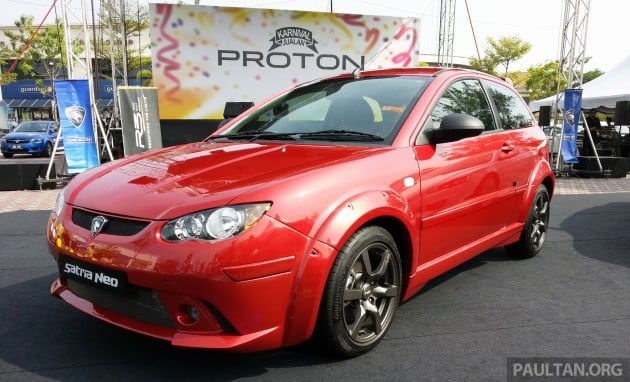Bad news, Proton Satria Neo fans. Production of the three-door hatchback will cease this year, according to a response by the national carmaker to a comment on its official Proton Motorsports Facebook page.
The second-generation Satria was first launched in Malaysia in 2006. Since then, the hatch has gone through many revisions, along with a switch up in the variants being offered. The most recent is the introduction of the Proton Satria Neo Standard 4AT in January last year.
Currently, the model is offered in five variants, all fitted with the 1.6 litre CamPro CPS in-line four-cylinder engine that churns out 125 hp at 6,500 rpm and 150 Nm of torque at 4,500 rpm. They are the 1.6 MT Standard, 1.6 AT Standard, 1.6 MT Standard with Aero Kit, R3 1.6 MT Executive, and R3 1.6 AT Executive.
In its near-10-year production run, the Proton Satria Neo has spawned several high-performance variants as well, including the R3 Satria Neo, which is not to be confused with the above-mentioned models. Built by the company’s motorsport division, the car received a Stage 2 performance upgrade that bumped power up to 145 hp at 7,000 rpm, and 168 Nm of torque at 5,000 rpm, sent through a close-ratio five-speed manual gearbox.
Even Lotus had a go working on the model, giving rise to the limited-number (only 25) Proton Satria Neo R3 Lotus Racing. With a bevy of performance enhancements, the car was certainly deserving of its “Lotus Racing” name. Lest we forget, the Proton Satria Neo was even converted for rally racing duties, known as the Neo S2000.
With the advent of this news, how do you feel about the end of the Proton Satria Neo’s production run?
AD: Drive the Proton model of your dreams. Submit your details and Proton PJ will get in touch with you.
Looking to sell your car? Sell it with Carro.
























AI-generated Summary ✨
Comments reflect a mix of nostalgia, disappointment, and hope regarding the Proton Satria Neo ending production. Many appreciate its sporty handling, design, and status as a beloved local car, with some bemoaning the lack of power, comfort, and interior quality. Several commenters express sadness about losing a car that holds sentimental value, while others worry about the future of Proton's sporty lineup and suggest potential successors like a new Satria model or rebranded Hondas. There are calls for Proton to develop a new, powerful, and good-looking Satria that retains its handling reputation, with some joking about engine swaps. Overall, the sentiment is bittersweet, emphasizing appreciation for the Neo’s charm and hopes for a worthy replacement.